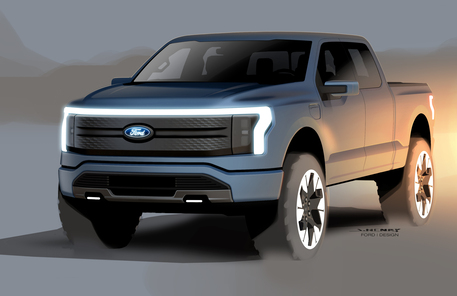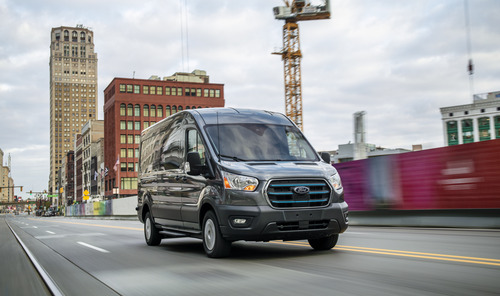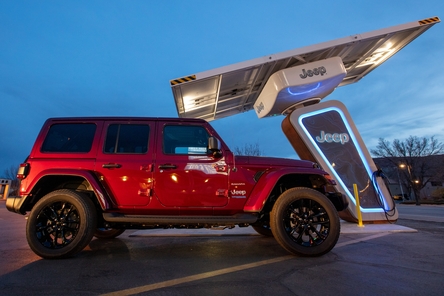BUSINESS
Modifying Consumers’ Electric Vehicles
Spotting Emerging Trends to Stay Ahead of the Curve
By Fredy Ramirez

at a fully electric truck and is set to be released in 2022.
Photo courtesy: Ford
Solely based on the moves OEMs are making, electric vehicles (EVs) are the future of the industry. It would be difficult to find a car manufacturer that doesn’t feature at least one electric vehicle in its lineup or that isn’t planning to include one soon.
“From a Ford Motor Company perspective, electrification is huge to us,” Ford Performance Motorsport Supervisor Brian Novack said. “I think we are spending $11.5 billion over the next few years in improving our electric-vehicle lineup.”
Those in the aftermarket who begin to take advantage of the opportunities arising in the EV market are going to be ahead of the curve. However, the aftermarket industry isn’t there yet, so where are the opportunities?
As of now, the only viable way to make an electric car faster is to give it a bigger battery. Companies such as AEM-EV optimize the performance of the battery using advanced data gathering and control systems for EVs, but the performance is still limited by the power the battery supplies.
“The only way a Tesla will go faster than your neighbor’s Tesla is if you removed all the seats from it and try to lighten it up,” said Steve Huff of Huff Motorsports.
The options for the aftermarket as of now are limited until the next wave of electric cars or until the other available platforms become easily modifiable. The next step for EVs are trucks, which are still in a development stage. Providing an all-electric truck is more challenging because not only are trucks heavier vehicles, trucks tend to haul and tow heavier items. However, Magna International is developing a technology to assist with the transitioning of trucks with its eBeam technology.

through a fully electric powertrain and next-level software.
Photo courtesy: Ford
“It is a bold endeavor to electrify pickup trucks, whose owners demand the towing and hauling capabilities they are currently used to, and we’ve accomplished it with our eBeam technology,” Magna Powertrain President Tom Rucker said. “We know axles are core elements of a truck’s strength, and we are excited to have developed the first significant improvement to the solid beam axle in more than 100 years.” The axle is being engineered to integrate hybrid or full battery electric powertrain systems with current truck designs without any change in the rest of the system. This should speed up the process as Rucker stated they are working with OEMs but couldn’t specify which ones.
As of now, the two most notable electric pickups on the way are Ford’s all-electric F-150 Lightning and Chevrolet’s all-electric Silverado. Their gas counterparts are some of the most heavily modified vehicles of any class, which bodes well for the aftermarket. “The F-150 Lightning is a massive moment for our Ford team. It’s quicker than a Raptor, with standard 4x4 and independent rear suspension; a power frunk, enough juice to run your house for three days or power an awesome tailgate; and it will forever improve with over-the-air updates,” said Ford President and CEO Jim Farley. Pickups have always been the aftermarket’s favorite vehicle class to modify, and it look like that should continue with this wave of electric vehicles.
Jeep is another major player that is becoming involved. It is on its way to developing a fully electric vehicle with its hybrid Wrangler 4xe, featuring a plug-in option.

foreshadowing its future with electric vehicles. Photo
courtesy: Jeep
“Millions of vehicles were sold in California last year,” said EV West Owner Michael Bream. “To try to make all of those electric in 14 years during a time when the largest American electric car manufactured delivered 500,000 cars last year is going to be hard to do. There is going to be such a profound change and scaling.”
Trucks are where aftermarket companies are going to make their living, because they are the most modified vehicle class in the industry. In fact, there are already hints of electric-powered trucks that could use aftermarket support. For the first time in its history, King of the Hammers featured an electric-powered 4Runner.
Given how advanced all those vehicles will be, the aftermarket faces some admitted challenges. Still, as new technologies continue to emerge, this market segment also promises growth opportunities. At the very least, investing now in EV research and development can help companies diversify product lines and secure future profits.
Sources
For more information on racing and performance, follow these sources on social media:
- @stevehuffmotorsports
- @vaughngittinjr
- @loren_healy
- @bailey_cole_racing
- @fordperformance






